The fin whale's body is long and slender, coloured brownish-grey with a paler underside. The fin whale is a large baleen whale that belongs to the Cetacean order, which includes all species of whale, dolphin and porpoise. At least two recognized subspecies exist, in the North Atlantic and the Southern Hemisphere. It is found in all the major oceans, from polar to tropical waters. It is absent only from waters close to the ice pack at the poles and relatively small areas of water away from the open ocean. The highest population density occurs in temperate and cool waters.[12] Its food consists of small schooling fish, squid, and crustaceans including copepods and krill.
Like all other large whales, the fin whale was heavily hunted during the 20th century and is an endangered species. Over 725,000 fin whales were reportedly taken from the Southern Hemisphere between 1905 and 1976; as of 1997 only 38,000 survived.[2] Recovery of the overall population size of southern species is predicted to be at less than 50% of its pre-whaling state by 2100 due to heavier impacts of whaling and slower recovery rates.[13]
The International Whaling Commission (IWC) issued a moratorium on commercial hunting of this whale,[14] although Iceland and Costa Rica have resumed hunting. The species is also hunted by Greenlanders under the IWC's Aboriginal Subsistence Whaling provisions. Global population estimates range from less than 100,000 to roughly 119,000.[2][15]
Taxonomy
A cladogram of animals related to the fin whale
Fin whales are rorquals, members of the family Balaenopteridae, which also includes the humpback whale, the blue whale, Bryde's whale, the sei whale, and the minke whales. The family diverged from the other baleen whales in the suborder Mysticeti as long ago as the middle Miocene,[19] although it is not known when the members of these families further evolved into their own species.
Recent DNA evidence indicates the fin whale may be more closely related to the humpback whale (Megaptera novaeangliae) and in at least one study the gray whale (Eschrichtius robustus), two whales in different genera, than it is to members of its own genus, such as the minke whales.[20][21][22][23] As of 2006, two subspecies are named, each with distinct physical features and vocalizations. The northern fin whale, B. p. physalus (Linnaeus 1758) inhabits the North Atlantic and the southern fin whale, B. p. quoyi (Fischer 1829) occupies the Southern Ocean.[24] Most experts consider the fin whales of the North Pacific to be a third, as yet unnamed subspecies – this was supported by a 2013 study, which found that the Northern Hemisphere B. p. physalus was not composed of a single subspecies. The three groups mix at most rarely.[25]
Clarke (2004) proposed a "pygmy" subspecies (B. p. patachonica, Burmeister, 1865) that is purportedly darker in colour and has black baleen. He based this on a single physically mature 19.8 m (65 ft) female caught in the Antarctic in 1947–48, the smaller average size (a few feet) of sexually and physically mature fin whales caught by the Japanese around 50°S, and smaller, darker sexually immature fin whales caught in the Antarctic which he believed were a "migratory phase" of his proposed subspecies. His proposal is not widely accepted and no genetic evidence for their existence is available.[2][26]
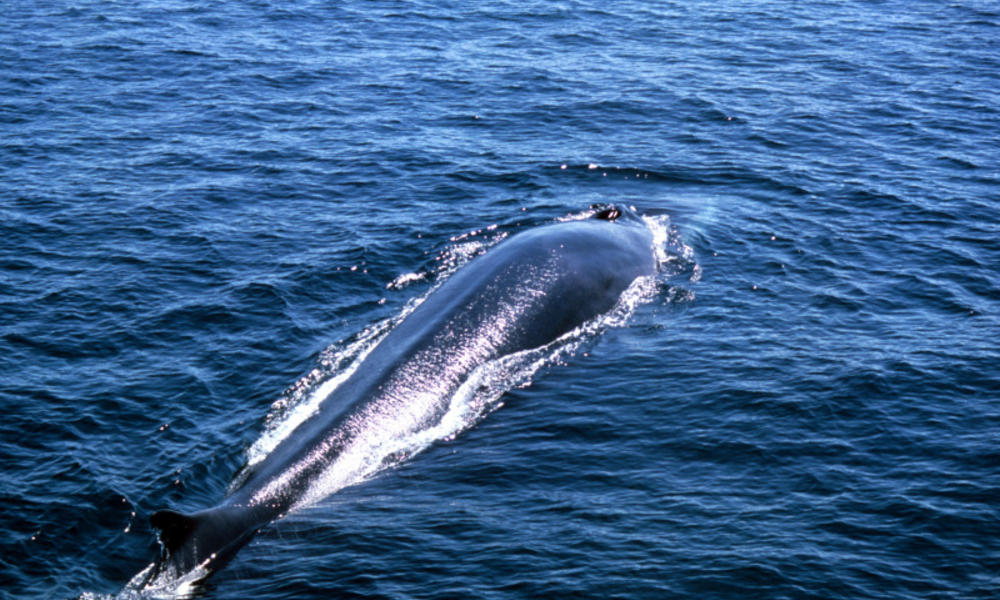
Hybrids
The genetic distance between blue and fin whales has been compared to that between a gorilla and human[27] (3.5 million years on the evolutionary tree.[28]) Nevertheless, hybrid individuals between blue and fin whales with characteristics of both are known to occur with relative frequency in both the North Atlantic and North Pacific.[29][30]
The DNA profile of a sampling of whale meat in the Japanese market found evidence of blue/fin hybrids.[31][32]
Anatomy
Fin whale skeleton
Fin whales often travel in pairs.
A fin whale in the Gulf of St. Lawrence, showing characteristic backswept dorsal fin
Fin whale arching for a deep dive
The animal's large size aids in identification, and it is usually only confused with the blue whale, the sei whale, or, in warmer waters, Bryde's whale.
Vocalizations
Size
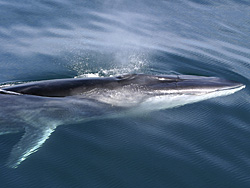
In the Northern Hemisphere, the average size of adult males and females is about 18.5 and 20 metres (61 and 66 ft), respectively, averaging 38.5 and 50.5 tonnes (42.5 and 55.5 tons),[10] while in the Southern Hemisphere, it is 20.5 and 22 m (67 and 72 ft),[33] weighing 52.5 and 63 tonnes (58 and 69.5 tons).[10]
In the North Atlantic, the longest reported were a 24.4 m (80 ft) male caught off Shetland in 1905 and a 25 m (82 ft) female caught off Scotland sometime between 1908 and 1914,[34][35] while the longest reliably measured were three 20.7 m (68 ft) males caught off Iceland in 1973–74 and a 22.5 m (74 ft) female also caught off Iceland in 1975.[36][37] Mediterranean population are generally smaller, reaching just above 20 m (65.5 ft) at maximum, or possibly up to 21–23 metres (68.9–75.5 ft).[38]
In the North Pacific, the longest reported were three 22.9 m (75 ft) males, two caught off California between 1919 and 1926 and the other caught off Alaska in 1925, and a 24.7 m (81 ft) female also caught off California, while the longest reliably measured were a 21 m (69 ft) male caught off British Columbia in 1959 and a 22.9 m (75 ft) female caught off central California between 1959 and 1970.[39][40][41] Whales historically seen in Yellow Sea could have been distinct from outer Pacific populations due to their smaller size of around 20 m or more at near maximum,[42] and breeding season in these regions was mainly in winter.
In the Southern Hemisphere, the longest reported for each sex were 25 and 27.3 m (82 and 90 ft), while the longest measured by Mackintosh and Wheeler (1929) were 22.65 and 24.53 m (74.3 and 80.5 ft).[8] Major F. A. Spencer, while whaling inspector of the factory ship Southern Princess (1936–38), confirmed the length of a 25.9 m (85 ft) female caught in the Antarctic, south of the Indian Ocean;[9] scientist David Edward Gaskin also measured a 25.9 m female as whaling inspector of the British factory ship Southern Venturer in the Southern Ocean in the 1961–62 season.[43] Terence Wise, who worked as a winch operator aboard the British factory ship Balaena, claimed that "the biggest fin [he] ever saw" was a 25.6 m (84 ft) specimen caught near Bouvet Island in January 1958.[44] The largest fin whale ever weighed (piecemeal) was a 22.7 m (74 ft) pregnant female caught by Japanese whalers in the Antarctic in 1948 which weighed 69.5 tonnes (68.4 long tons), not including 6% for loss of fluids during the flensing process.[10] An individual at the maximum confirmed size of 25.9 meters (85 feet) is estimated to weigh around 95 tonnes (104.5 tons),[10] varying from about 76 tonnes (84 tons) to 114 tonnes (125.5 tons) depending on fat condition which varies by about 50% during the year.[45]
A newborn fin whale measures about 6.0–6.5 m (19.7–21.3 ft) in length and weighs about 1,800 kilograms (4,000 lb).[46]
Colouration and markings
Porcupine Seabight, South West Ireland
Fin whale showing colouring on right side
Porcupine Seabight, South West Ireland, showing chevrons
When the whale surfaces, the dorsal fin is visible soon after the spout. The spout is vertical and narrow and can reach heights of 6 m (20 ft) or more.[15]
Nervous system
The oral cavity of the fin whale has a very stretchy or extensible nerve system which aids them in feeding.[48]Life history
Mating occurs in temperate, low-latitude seas during the winter, followed by an 11- to 12-month gestation period. A newborn weans from its mother at 6 or 7 months of age when it is 11 to 12 m (36 to 39 ft) in length, and the calf accompanies the mother to the summer feeding ground. Females reproduce every 2 or 3 years, with as many as six fetuses being reported, but single births are far more common. Females reach sexual maturity between 6 and 12 years of age at lengths of 17.7–19 m (58–62 ft) in the Northern Hemisphere and 20 m (66 ft) in the Southern Hemisphere.[33] Calves remain with their mothers for about one year.[49]
Full physical maturity is attained between 25 and 30 years. Fin whales have a maximum life span of at least 94 years of age,[50] although specimens have been found aged at an estimated 135–140 years.[51]
The fin whale is one of the fastest cetaceans and can sustain speeds between 37 km/h (23 mph)[46] and 41 km/h (25 mph) and bursts up to 46 km/h (29 mph) have been recorded, earning the fin whale the nickname "the greyhound of the sea".[52]
Fin whales are more gregarious than other rorquals, and often live in groups of 6–10, although feeding groups may reach up to 100 animals.[50]
Like other whales, males make long, loud, low-frequency sounds.[46] The vocalizations of blue and fin whales are the lowest-frequency sounds made by any animal.[53] Most sounds are frequency-modulated (FM) down-swept infrasonic pulses from 16 to 40 hertz frequency (the range of sounds that most humans can hear falls between 20 hertz and 20 kilohertz). Each sound lasts one to two seconds, and various sound combinations occur in patterned sequences lasting 7 to 15 minutes each. The whale then repeats the sequences in bouts lasting up to many days.[54] The vocal sequences have source levels of up to 184–186 decibels relative to 1 micropascal at a reference distance of one metre and can be detected hundreds of miles from their source.[55]
When fin whale sounds were first recorded by US biologists, they did not realize that these unusually loud, long, pure and regular sounds were being made by whales. They first investigated the possibilities that the sounds were due to equipment malfunction, geophysical phenomena, or even part of a Soviet Union scheme for detecting enemy submarines. Eventually, biologists demonstrated that the sounds were the vocalizations of fin whales.[53]
Direct association of these vocalizations with the reproductive season for the species and that only males make the sounds point to these vocalizations as possible reproductive displays.[56][57] Over the past 100 years, the dramatic increase in ocean noise from shipping and naval activity may have slowed the recovery of the fin whale population, by impeding communications between males and receptive females.[58]
Breathing
When feeding, they blow 5–7 times in quick succession, but while traveling or resting will blow once every minute or two. On their terminal (last) dive they arch their back high out of the water, but rarely raise their flukes out of the water. They then dive to depths of up to 470 metres (1,540 ft) when feeding or a few hundred feet when resting or traveling. The average feeding dive off California and Baja lasts 6 minutes, with a maximum of 17 minutes; when traveling or resting they usually dive for only a few minutes at a time.[59]Ecology
Range and habitat
Aerial view of a fin whale, showing V-shaped chevron
Fin whale off Greenland, showing asymmetrical colouration (including
right mandible patch, blaze, interstripe wash and chevron, and dark eye
and ear stripes)
The North Atlantic fin whale has an extensive distribution, occurring from the Gulf of Mexico and Mediterranean Sea, northward to Baffin Bay and Spitsbergen. In general, fin whales are more common north of approximately 30°N latitude, but considerable confusion arises about their occurrence south of 30°N latitude because of the difficulty in distinguishing fin whales from Bryde's whales.[64] Extensive ship surveys have led researchers to conclude that the summer feeding range of fin whales in the western North Atlantic is mainly between 41°20'N and 51°00'N, from shore seaward to the 1,000 fathoms (1,800 m) contour.[65]
Summer distribution of fin whales in the North Pacific is the immediate offshore waters from central Baja California to Japan and as far north as the Chukchi Sea bordering the Arctic Ocean.[66] They occur in high densities in the northern Gulf of Alaska and southeastern Bering Sea between May and October, with some movement through the Aleutian passes into and out of the Bering Sea.[67] Several whales tagged between November and January off southern California were killed in the summer off central California, Oregon, British Columbia, and in the Gulf of Alaska.[66] Fin whales have been observed feeding 250 miles south of Hawaii in mid-May, and several winter sightings have been made there.[68] Some researchers have suggested that the whales migrate into Hawaiian waters primarily in the autumn and winter.[69]
Although fin whales are certainly migratory, moving seasonally in and out of high-latitude feeding areas, the overall migration pattern is not well understood. Acoustic readings from passive-listening hydrophone arrays indicate a southward migration of the North Atlantic fin whale occurs in the autumn from the Labrador-Newfoundland region, south past Bermuda, and into the West Indies.[70] One or more populations of fin whales are thought to remain year-round in high latitudes, moving offshore, but not southward in late autumn.[70] A study based on resightings of identified fin whales in Massachusetts Bay indicates that calves often learn migratory routes from their mothers and return to their mother's feeding area in subsequent years.[49]
In the Pacific, migration patterns are poorly characterized. Although some fin whales are apparently present year-round in the Gulf of California, there is a significant increase in their numbers in the winter and spring.[71] Southern fin whales migrate seasonally from relatively high-latitude Antarctic feeding grounds in the summer to low-latitude breeding and calving areas in the winter. The location of winter breeding areas is still unknown, since these whales tend to migrate in the open ocean.[12]
Population and trends
A frontal view of a fin whale, showing asymmetrical colouration
North Atlantic
Drawing of a fin whale on a Faroese stamp, issued 17 September 2001
A possible resident group was in waters off the Cape Verde Islands in 2000 and 2001.[84]
Mediterranean Sea
Fin whale and a boat in the Strait of Gibraltar.
North Pacific
Finback Whale Skull, San Diego Natural History Museum
For Asian stocks, resident groups may exist in the Yellow Sea and East China Sea, and the Sea of Japan (though these populations are critically endangered and the population off China, Korea, and Japan are either near extinction or in very small numbers). Very small increases in sightings have been confirmed off Shiretoko Peninsula, Abashiri, and Kushiro[117] in Hokkaido, Tsushima, Sado Island,[118] off Maiduru[119] in the Sea of Japan since in late 2000s as whales in Sea of Okhotsk might have started recolonizing into former habitats (for coastal Sakhalin, as well). Whales possibly used to migrated into Seto Inland Sea.
Studies of historical catches suggest several resident groups once existed in the North Pacific – the Baja California group and the Yellow Sea–East China Sea (including Ryukyu Islands and western Kyusyu) group.[120] Additionally, respective groups in northern Sea of Japan and the group along Pacific coasts of Japan from Hokkaido to Sanriku might have been resident or less migratory, as well. The only modern record among Ryukyu Islands was of a rotten carcass beached on Ishigaki Island in 2005.[121] Regarding Yellow Sea, a juvenile was accidentally killed along Boryeong in 2014.[122]
There had been congregation areas among Sea of Japan to Yellow Sea such as in East Korea Bay, along eastern coasts of Korean Peninsula, and Ulleungdo.[123]
Modern sightings around the Commander Islands have been annual but not in great numbers, and whales likely to migrate through the areas rather than summering, and possible mixing of western and eastern populations are expected to occur in this waters.[124]
South Pacific
Very little information has been revealed about the ecology of current migration from Antarctic waters are unknown, but small increases in sighting rates are confirmed off New Zealand, such as off Kaikoura, and wintering grounds may exist in further north such as in Papua New Guinea, Fiji,[125] and off East Timor. Confirmations in Rarotonga have been increased recently[126] where interactions with humpback whales occur on occasions.[127] Finbacks are also relatively abundant along the coast of Peru and Chile (in Chile, most notably off Los Lagos region such as Gulf of Corcovado[128] in Chiloé National Park, Punta de Choros[es],[129][130] port of Mejillones,[131][132] and Caleta Zorra. Year-round confirmations indicate possible residents off pelagic north eastern to central Chile such as around coastal Caleta Chañaral[es] and Pingüino de Humboldt National Reserve, east of Juan Fernández Islands, and northeast of Easter Island and possible wintering ground exist for eastern south Pacific population.[133] They are known to make mixed groups with other rorquals such as blue whales and sei whales. Their recovery is confirmed vicinity to various subantarctic islands such as South Georgia and Falkland, but unknown in other historical habitats including Campbell Island, Kermadec to Chatham Islands, Tristan da Cunha, and Gough Island.Other
Among Northern Indian Ocean and Bay of Bengal, such as along Sri Lanka, India, and Malaysia, sightings and older records of fin whales exist.[134][135][136]Antarctica
Relatively little is known about the historical and current population levels of the Southern fin whale. The IWC officially estimates that the Southern Hemisphere pre-whaling population was 400,000 whales and that the population in 1979 (at the cessation of Antarctic large scale whaling) was 85,200.[137] Both the current and historical estimates should be considered as poor estimates because the methodology and data used in the study are known to be flawed.[12] Other estimates cite current size to be between 15,000 (1983) and 38,000 (1997).[2] As of 2006, there is no scientifically accepted estimate of current population or trends in abundance.[12]Predation
The only known predator of the fin whale is the killer whale, with at least 20 eyewitness and second-hand accounts of attack or harassment. They usually flee and offer little resistance to attack. Only a few confirmed fatalities have occurred. In October 2005, 16 killer whales attacked and killed a fin whale in the Canal de Ballenas, Gulf of California, after chasing it for about an hour. They fed on its sinking carcass for about 15 minutes before leaving the area. In June 2012, a pod of killer whales was seen in La Paz Bay, in the Gulf of California, chasing a fin whale for over an hour before finally killing it and feeding on its carcass. The whale bore numerous tooth rakes over its back and dorsal fin; several killer whales flanked it on either side, with one individual visible under water biting at its right lower jaw.[138] In July 1908, a whaler reportedly saw two killer whales attack and kill a fin whale off western Greenland. In January 1984, seven were seen from the air circling, holding the flippers, and ramming a fin whale in the Gulf of California, but the observation ended at nightfall.[139][140]Feeding
Overhead view of a fin whale feeding
Fin whale lunge feeding at the surface
Fin whale being flensed at the Hvalfjörður whaling station in Iceland, showing the baleen bristles used to filter prey organisms
The whaling historian Sigurd Risting sitting on the baleen bristles of a fin whale landed at a whaling station in the Shetland Islands (1912)
In the North Pacific, they feed on euphausiids in the genera Euphausia, Thysanoessa, and Nyctiphanes, large copepods in the genus Neocalanus, small schooling fish (e.g. the genera Engraulis, Mallotus, Clupea, and Theragra), and squid. Based on stomach content analysis of over 19,500 fin whales caught by the Japanese whaling fleet in the North Pacific from 1952 to 1971, 64.1% contained only krill, 25.5% copepods, 5.0% fish, 3.4% krill and copepods and 1.7% squid.[141] Nemoto (1959) analysed the stomach contents of about 7500 fin whales caught in the northern North Pacific and Bering Sea from 1952 to 1958, found that they mainly preyed on euphausiids around the Aleutian Islands and in the Gulf of Alaska and schooling fish in the northern Bering Sea and off Kamchatka. In the northern Bering Sea (north of 58°N), their main prey species were capelin (Mallotus villosus), Alaska pollock (Theragra chalcogramma) and Pacific herring (Clupea pallasii); they also consumed saffron cod (Eleginus gracilis). Arctic krill (Thysanoessa raschii) was the only species of euphausiid found in the stomachs of fin whales in the northern Bering Sea. Off Kamchatka, they appeared to primarily feed on herring. They also took large quantities of the copepod Neocalanus cristatus around the Aleutian Islands and in Olyutorsky Bay off northeast Kamchatka, areas where the species was abundant. Five species of euphausiid (Euphausia pacifica, Thysanoessa spinifera, T. inermis, T. raschii, and T. longipes) were the predominant prey around the Aleutian Islands and in the Gulf of Alaska. Prey varied by region in the Kuril Islands area, with euphausiids (T. longipes, T. inermis, and T. raschii) and copepods (Neocalanus plumchrus and N. cristatus) being the main prey in the northern area and Japanese flying squid (Todarodes pacificus pacificus) and small schooling fish (e.g. Pacific saury, Cololabis saira; and Japanese anchovy, Engraulis japonicus) dominating the diet in the southern area.[142]
Of the fin whale stomachs sampled off British Columbia between 1963 and 1967, euphausiids dominated the diet for four of the five years (82.3 to 100% of the diet), while copepods only formed a major portion of the diet in 1965 (35.7%). Miscellaneous fish, squid, and octopus played only a very minor part of the diet in two of the five years (3.6 to 4.8%).[143] Fin whales caught off California between 1959 and 1970 fed on the pelagic euphausiid Euphausia pacifica (86% of sampled individuals), the more neritic euphausiid Thysanoessa spinifera (9%), and the northern anchovy (Engraulis mordax) (7%); only trace amounts (<0.5% each) were found of Pacific saury (C. saira) and juvenile rockfish (Sebastes jordani).[144] In the Gulf of California, they have been observed feeding on swarms of the euphausiid Nyctiphanes simplex.
In the North Atlantic, they prey on euphausiids in the genera Meganyctiphanes, Thysanoessa and Nyctiphanes and small schooling fish (e.g. the genera Clupea, Mallotus, and Ammodytes). Of the 1,609 fin whale stomachs examined at the Hvalfjörður whaling station in southwestern Iceland from 1967 to 1989 (caught between June and September), 96% contained only krill, 2.5% krill and fish, 0.8% some fish remains, 0.7% capelin (M. villosus), and 0.1% sandeel (family Ammodytidae); a small proportion of (mainly juvenile) blue whiting (Micromesistius poutassou) were also found. Of the krill sampled between 1979 and 1989, the vast majority (over 99%) was northern krill (Meganyctiphanes norvegica); only one stomach contained Thysanoessa longicaudata.[145] Off West Greenland, 75% of the fin whales caught between July and October had consumed krill (family Euphausiidae), 17% capelin (Mallotus) and 8% sand lance (Ammodytes sp.). Off eastern Newfoundland, they chiefly feed on capelin, but also take small quantities of euphausiids (mostly T. raschii and T. inermis).[73] In the Ligurian-Corsican-Provençal Basin in the Mediterranean Sea they make dives as deep as 470 metres (1,540 ft) to feed on the euphausiid Meganyctiphanes norvegica, while off the island of Lampedusa, between Tunisia and Sicily, they have been observed in mid-winter feeding on surface swarms of the small euphausiid Nyctiphanes couchi.[146]
In the Southern Hemisphere, they feed almost exclusively on euphausiids (mainly the genera Euphausia and Thysanoessa), as well as taking small amounts of amphipods (e.g. Themisto gaudichaudii) and various species of fish. Of the more than 16,000 fin whales caught by the Japanese whaling fleet in the Southern Hemisphere between 1961 and 1965 that contained food in their stomachs, 99.4% fed on euphausiids, 0.5% on fish, and 0.1% on amphipods.[141] In the Southern Ocean they mainly consume E. superba.[147][148][149]
The animal feeds by opening its jaws while swimming at some 11 kilometres per hour (6.8 mph) in one study,[150] which causes it to engulf up to 70 cubic metres (18,000 US gal; 15,000 imp gal) of water in one gulp. It then closes its jaws and pushes the water back out of its mouth through its baleen, which allows the water to leave while trapping the prey. An adult has between 262 and 473 baleen plates on each side of the mouth. Each plate is made of keratin that frays out into fine hairs on the ends inside the mouth near the tongue. Each plate can measure up to 76 centimetres (30 in) in length and 30 centimetres (12 in) in width.[7]
The whale routinely dives to depths of more than 200 metres (660 ft) where it executes an average of four "lunges", to accumulate krill. Each gulp provides the whale with approximately 10 kilograms (22 lb) of food.[150] One whale can consume up to 1,800 kilograms (4,000 lb) of food a day,[7] leading scientists to conclude that the whale spends about three hours a day feeding to meet its energy requirements, roughly the same as humans. If prey patches are not sufficiently dense, or are located too deep in the water, the whale has to spend a larger portion of its day searching for food.[150] One hunting technique is to circle schools of fish at high speed, frightening the fish into a tight ball, then turning on its side before engulfing the massed prey.[7]
Pathology
Fin whales suffer from a number of pathological conditions. The parasitic copepod Pennella balaenopterae—usually found on the flank of fin whales—burrows into their blubber to feed on their blood,[151] while the pseudo-stalked barnacle Xenobalanus globicipitis is generally found more often on the dorsal fin, pectoral fins, and flukes.[152]Other barnacles found on fin whales include the acorn barnacle Coronula reginae and the stalked barnacle Conchoderma auritum, which attaches to Coronula or the baleen. The harpacticid copepod Balaenophilus unisetus (heavy infestations of which have been found in fin whales caught off northwestern Spain) and the ciliate Haematophagus also infest the baleen, the former feeding on the baleen itself and the latter on red blood cells.[9]
The remora Remora australis and occasionally the amphipod Cyamus balaenopterae can also be found on fin whales, both feeding on the skin. Infestations of the giant nematode Crassicauda boopis can cause inflammation of the renal arteries and potential kidney failure, while the smaller C. crassicauda infects the lower urinary tract.[113]
An emaciated 13 m (43 ft) female fin whale, which stranded along the Belgian coast in 1997, was found to be infected with lesions of Morbillivirus.[153] In January 2011, a 16.7 m (55 ft) emaciated adult male fin whale stranded dead on the Tyrrhenian coastline of Italy was found to be infected with Morbillivirus and the protozoa Toxoplasma gondii, as well as carrying heavy loads of organochlorine pollutants.[154]
Human interaction
Whaling
A 65-long-ton (66 t), 72 ft (22 m) fin whale caught at Grays Harbor circa 1912
"The Finback" (Balaenoptera velifera, Cope) from Charles Melville Scammon's Marine Mammals of the North-western coast of North America (1874)
The introduction of factory ships with stern slipways in 1925 substantially increased the number of whales taken per year. In 1937–38 alone, over 29,000 fin whales were taken. From 1953–54 to 1961–62, the catch averaged over 30,000 per year. By 1962–63, sei whale catches began to increase as fin whales became scarce. By 1975–76, fewer than 1,000 fin whales were being caught each year. In the North Pacific, over 74,000 fin whales were caught between 1910 and 1975.[157] Between 1910 and 1989, over 55,000 were caught in the North Atlantic.[158] Coastal groups in northeast Asian waters, along with many other baleen species, were likely driven into serious perils or functional extinctions by industrial catches by Japan covering wide ranges of China and Korean EEZ within very short period in 20th century.[159] Migrations of the species into Japanese EEZ and in East China Sea were likely to be exterminated relatively earlier, as the last catch records on Amami Oshima was between the 1910s and 1930s.[160] After the cease of exploiting Asian stocks, Japan kept mass commercial and illegal hunts until 1975. Several thousand individuals were hunted from various stations mainly along coasts of Hokkaido, Sanriku, and the Gotō Islands.[161]
The IWC prohibited hunting in the Southern Hemisphere in 1976.[156] The Soviet Union engaged in the illegal killing of protected whale species in the North Pacific and Southern Hemisphere, over-reporting fin whale catches to cover up illegal takes of other species. In the North Pacific, they reported taking over 10,000 fin whales between 1961–79, while the true catch was less than 9,000. In the Southern Hemisphere, they reported taking nearly 53,000 between 1948 and 1973, when the true total was a little over 41,000.[162][163][164] The fin whale was given full protection from commercial whaling by the IWC in the North Pacific in 1976, and in the North Atlantic in 1987, with small exceptions for aboriginal catches and catches for research purposes.[46] All populations worldwide remain listed as endangered species by the US National Marine Fisheries Service and the International Conservation Union Red List. The fin whale is on Appendix 1 of CITES.[2][165][166]
The IWC has set a quota of 19 fin whales per year for Greenland. Meat and other products from whales killed in these hunts are widely marketed within Greenland, but export is illegal. Iceland and Norway are not bound by the IWC's moratorium on commercial whaling because both countries filed objections to it.[12]
In October 2006, Iceland's fisheries ministry authorized the hunting of 9 fin whales through August 2007.[167] In 2009 and 2010, Iceland caught 125 and 148 fin whales, respectively.[168] An Icelandic company, Hvalur, caught over a hundred fin whales in 2014, and exported a record quantity of 2071 tonnes in a single shipment in 2014. Since 2006, Hvalur has caught more than 500 fin whales and exported more than 5000 tonnes of whale meat to Japan.[169]
In the Southern Hemisphere, Japan permits annual takes of 10 fin whales under its Antarctic Special Permit whaling program for the 2005–2006 and 2006–2007 seasons.[170] The proposal for 2007–2008 and the subsequent 12 seasons allows taking 50 per year.[12] While 10 fin whales were caught in the 2005–06 season and three in the 2006–07 season, none was caught in the 2007–2008 season. A single fin whale was caught in both the 2008–09 and 2009–10 seasons, two were taken in the 2010–11 season, and one was taken in the 2011–12 season.[171]
Fin whales have been targets of illegal captures using harpoons for dolphin hunts or intentionally drive whales into nets.[32]
Ship interaction
Collisions with ships are a major cause of mortality. In some areas, they cause a substantial portion of large whale strandings. Most serious injuries are caused by large, fast-moving ships over or near continental shelves.[172]A 60-ft-long fin whale was found stuck on the bow of a container ship in New York harbor on 12 April 2014.[173]
Ship collisions frequently occur in Tsushima Strait and result in damaging all of whales, passengers, and vessels, hence the Japanese Coast Guard has started visual recordings of large cetaceans in Tsushima Strait to inform operating vessels in the areas.[174]
Museums
An 18.8 m (62 ft) fin whale skeleton at the Oceanographic Museum in Monaco
Several fin whale skeletons are also exhibited in Europe. The Natural History Museum of Slovenia in Ljubljana, Slovenia, houses a 13 m (43 ft) female fin whale skeleton – the specimen had been found floating in the Gulf of Piran in the spring of 2003.[178] The Hungarian Natural History Museum in Budapest, Hungary, displays a fin whale skeleton hanging near its main entrance which had been caught in the Atlantic Ocean in 1896 and purchased from Vienna in 1900.[179] The Cambridge University Museum of Zoology, in Cambridge, United Kingdom, exhibits a nearly 21 m (69 ft) male fin whale skeleton, which had stranded at Pevensey, East Sussex, in November 1865.[180]
The Otago Museum, in Dunedin, New Zealand, displays a 16.76 m (55.0 ft) fin whale skeleton, which had stranded on the beach at Nelson at the entrance of the Waimea River in 1882.[181]
Whale watching
Fin whales are regularly encountered on whale-watching excursions worldwide. In the Southern California Bight, fin whales are encountered year-round, with the best sightings between November and March. They can even be seen from land (for example, from Point Vicente, Palos Verdes, where they can be seen lunge feeding at the surface only a half mile to a few miles offshore). They are regularly sighted in the summer and fall in the Gulf of St. Lawrence,[182] the Gulf of Maine, the Bay of Fundy, the Bay of Biscay, Strait of Gibraltar, the Mediterranean. In southern Ireland, they are seen inshore from June to February, with peak sightings in November and December.[183] Cruise ships en route to and from the Antarctic Peninsula sometimes encounter fin whales in the Drake Passage.Conservation
A immature fin whale in distress off national park of Caesarea Maritima
It is listed on Appendix II[184] as it has an unfavourable conservation status or would benefit significantly from international co-operation organised by tailored agreements. In addition, the fin whale is covered by the Agreement on the Conservation of Cetaceans in the Black Sea, Mediterranean Sea and Contiguous Atlantic Area (ACCOBAMS) and the Memorandum of Understanding for the Conservation of Cetaceans and Their Habitats in the Pacific Islands Region (Pacific Cetaceans MOU).[185]
Fin whale range
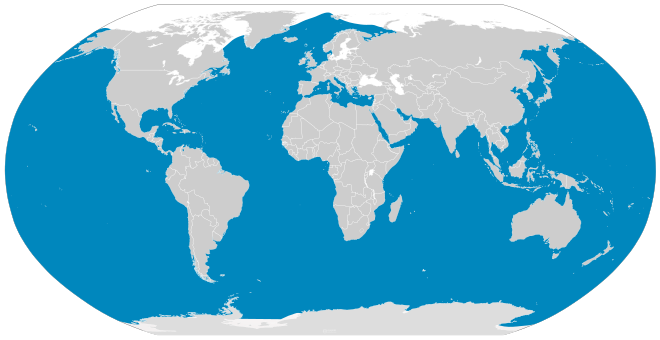








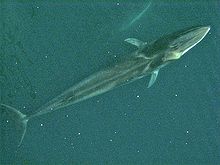

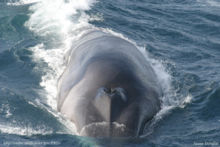

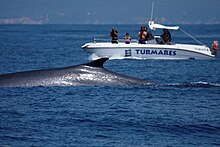

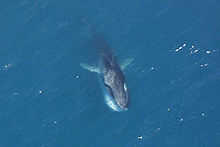

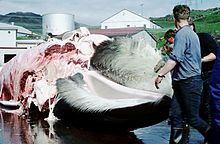




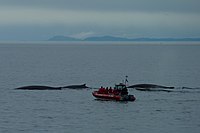


No comments:
Post a Comment
Note: Only a member of this blog may post a comment.